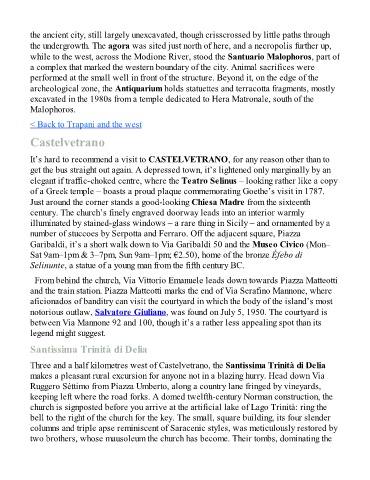Page 540 - The Rough Guide of Sicily
P. 540
the ancient city, still largely unexcavated, though crisscrossed by little paths through
the undergrowth. The agora was sited just north of here, and a necropolis further up,
while to the west, across the Modione River, stood the Santuario Malophoros, part of
a complex that marked the western boundary of the city. Animal sacrifices were
performed at the small well in front of the structure. Beyond it, on the edge of the
archeological zone, the Antiquarium holds statuettes and terracotta fragments, mostly
excavated in the 1980s from a temple dedicated to Hera Matronale, south of the
Malophoros.
< Back to Trapani and the west
Castelvetrano
It’s hard to recommend a visit to CASTELVETRANO, for any reason other than to
get the bus straight out again. A depressed town, it’s lightened only marginally by an
elegant if traffic-choked centre, where the Teatro Selinus – looking rather like a copy
of a Greek temple – boasts a proud plaque commemorating Goethe’s visit in 1787.
Just around the corner stands a good-looking Chiesa Madre from the sixteenth
century. The church’s finely engraved doorway leads into an interior warmly
illuminated by stained-glass windows – a rare thing in Sicily – and ornamented by a
number of stuccoes by Serpotta and Ferraro. Off the adjacent square, Piazza
Garibaldi, it’s a short walk down to Via Garibaldi 50 and the Museo Civico (Mon–
Sat 9am–1pm & 3–7pm, Sun 9am–1pm; €2.50), home of the bronze Éfebo di
Selinunte, a statue of a young man from the fifth century BC.
From behind the church, Via Vittorio Emanuele leads down towards Piazza Matteotti
and the train station. Piazza Matteotti marks the end of Via Serafino Mannone, where
aficionados of banditry can visit the courtyard in which the body of the island’s most
notorious outlaw, Salvatore Giuliano, was found on July 5, 1950. The courtyard is
between Via Mannone 92 and 100, though it’s a rather less appealing spot than its
legend might suggest.
Santissima Trinità di Delia
Three and a half kilometres west of Castelvetrano, the Santissima Trinità di Delia
makes a pleasant rural excursion for anyone not in a blazing hurry. Head down Via
Ruggero Séttimo from Piazza Umberto, along a country lane fringed by vineyards,
keeping left where the road forks. A domed twelfth-century Norman construction, the
church is signposted before you arrive at the artificial lake of Lago Trinità: ring the
bell to the right of the church for the key. The small, square building, its four slender
columns and triple apse reminiscent of Saracenic styles, was meticulously restored by
two brothers, whose mausoleum the church has become. Their tombs, dominating the

